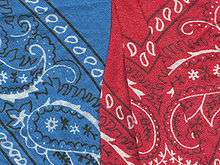Kerchief



A kerchief (from the French couvre-chef, "cover the head") also known as a bandana or bandanna, is a triangular or square piece of cloth tied around the head or around the neck for protective or decorative purposes. The popularity of head kerchiefs may vary by culture or religion, as among Orthodox Jewish and Christian, Amish, and Muslim women. It is also worn as headdresses by Malay men in traditional occasions such as weddings by the grooms and the pesilat. Their headdresses are better known as tengkolok.
The neckerchief and handkerchief are related items of clothing or accessories.
Society
The popularity of the bandana and kerchief was at it highest point in the 1970s, 80s and 90s depending on one's location. After that its popularity started waning in the west, but some eastern cultures maintained its usage for a while, such as in the Persian Gulf countries. It is largely seen as gender neutral and can be worn by both men and women. Its usage, when wrapped up, was partially replaced by the headband.
Bandana
A bandana or bandanna (from Sanskrit बन्धन or bandhana, "a bond") is a type of large, usually colorful kerchief, often worn on the head or around the neck of a person. It is not considered to be a hat.[1] Bandanas are frequently printed in a paisley pattern and are most often used to hold hair back, either as a fashionable head accessory, or for practical purposes.
Bandanas originated in India as bright coloured handkerchiefs of silk and cotton with spots in white on coloured grounds, chiefly red and blue. The silk styles were made of the finest quality yarns, and were very popular. Bandana prints for clothing were first produced in Glasgow from cotton yarns, and are now made in many qualities. The term, at present, generally means a fabric in printed styles, whether silk, silk and cotton, or all cotton.[3]
The word bandana stems from the Hindi words 'bāndhnū,' or "tie-dyeing," and 'bāndhnā,' "to tie." These stem from Sanskrit roots 'bandhnāti,' "he ties," and Sanskrit 'bandhana' (बन्धन), "a bond."[4]
American gang culture
Colors can be worn as a means of communication or identification, as with the prominent California criminal gangs, the Bloods, the Crips, the 18th Street gang, and MS-13. In gang subcultures, the bandana could be worn in a pocket or around the head. In the late 1960s/early 1970s, the Bloods and the Crips wore red and blue paisley bandanas respectively as a signifier of gang affiliation through the display of their gang colors.
See also
|
Other neckwear: |
Other headwear |
References
- 1 2 "Definition of bandanna". Merriam-webster.com. 2012-08-31. Retrieved 2013-03-15.
- ↑ "Bandanna from Dictionary.com". Dictionary.reference.com. Retrieved 2013-03-15.
- ↑ Curtis, H. P. (1921). Glossary of Textile Terms. Marsden & Co. Ltd.
- ↑ "Bandanna from Dictionary.com". Dictionary.reference.com. Retrieved 2017-06-10.
External links
| Wikisource has the text of the 1911 Encyclopædia Britannica article Bandana. |
| Wikimedia Commons has media related to Kerchiefs. |
